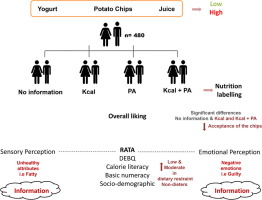Food Research International ( IF 7.0 ) Pub Date : 2020-03-17 , DOI: 10.1016/j.foodres.2020.109166 Denize Oliveira 1 , Hans De Steur 1 , Sofie Lagast 1 , Xavier Gellynck 1 , Joachim J Schouteten 1

|
Providing labelling information is one of the strategies used to help consumers make healthier choices. However, although the type of information has the potential to assist consumers, it is important to evaluate their sensory and emotional perceptions. Therefore, the objective of this study was to evaluate the effect of different labelling information on consumers’ sensory and emotional perceptions and their choices, for three different products (potato chips, juice and yogurt). A total of 480 participants were randomly assigned to one of four information conditions (no information (blind), kilocalorie (kcal) information, physical activity (PA) information [duration of walking required to burn the kcal in the product], kcal + PA information). For each information condition, participants were provided with higher kcal and lower kcal equivalent food pairs and were required to choose one. The participants evaluated their overall liking using a 9-point hedonic scale and answered rate-all-that-apply (RATA) questions related to the sensory and emotional characteristics of the products. The results showed no significant impact of calorie and physical activity labelling on consumers' overall liking for juice and yogurt samples and no impact of PA information for chips. Significant differences in overall liking were found when compared to the blind condition with kcal and kcal + PA information, with lower acceptance of the chips samples when this information was presented. Although providing calorie and physical activity labelling had little impact on consumers’ sensory and emotional perceptions, consumers perceived unhealthy attributes and negative emotions, such as fatty and guilty, when information was presented. The present work suggests that, although nutrition labelling may be presented as an important strategy to assist consumers, it is important to evaluate consumers’ lifestyles, considering that non-dieters and those low and moderate in dietary restraint may not be impacted by this information.
中文翻译:

卡路里和体育活动标签对消费者的情绪感知和食物选择的影响。
提供标签信息是用来帮助消费者做出更健康选择的策略之一。然而,尽管信息的类型有可能帮助消费者,但评估他们的感官和情绪感知非常重要。因此,本研究的目的是针对三种不同的产品(土豆片,果汁和酸奶)评估不同标签信息对消费者的感官和情感知觉及其选择的影响。总共480名参与者被随机分配到以下四个信息条件之一(无信息(盲人),千卡(kcal)信息,身体活动(PA)信息[在产品中燃烧kcal所需的行走时间],kcal + PA信息)。对于每个信息条件,为参与者提供了较高的大卡和较低的大卡当量食物对,并要求他们选择其中一对。参与者使用9点享乐量表评估了他们的总体喜好,并回答了与产品的感官和情绪特征有关的所有应用率(RATA)问题。结果表明,热量和体育锻炼标签对消费者对果汁和酸奶样品的总体喜好没有显着影响,对芯片的PA信息也没有影响。当与具有kcal和kcal + PA信息的盲条件相比时,发现总体喜好存在显着差异,而在呈现此信息时,芯片样本的接受度较低。尽管提供卡路里和身体活动标签对消费者的感官和情绪感知影响不大,提出信息时,消费者会感到不健康的属性和负面情绪,例如脂肪和内gui。目前的工作表明,尽管营养标签可以作为帮助消费者的重要策略,但考虑到非饮食者和饮食控制程度低和中等的人可能不受此信息影响,因此评估消费者的生活方式也很重要。











































 京公网安备 11010802027423号
京公网安备 11010802027423号